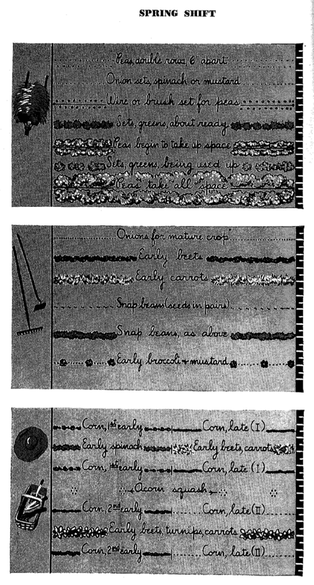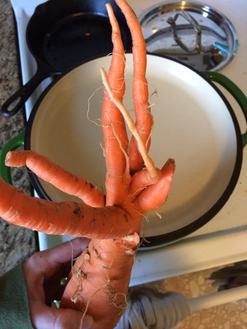(AKA Experiments with Storify)
Special thanks to the whole Smithsonian Staff led by Paula Johnson and Susan Evans, the presenters and moderators, and also to my co-tweeters, especially the fantastic Emily Contois!
(AKA Experiments with Storify)
I attended the amazing, marvelous, fantastic Food History Roundtables event at the Smithsonian on Friday. During the event, I and a few others live-tweeted it so that people unable to attend could still experience a bit of the magic on twitter -- and even submit questions there for the speakers! The hashtag for this event and all other food-related things at American History is #SmithsonianFood. (Click through and check out its mentions for a much more complete and chaotic overview of the event.) Here's a summary of my live-tweeting experimentally created on storify, for those interested in the conversations swirling around the NMAH on Friday!
Special thanks to the whole Smithsonian Staff led by Paula Johnson and Susan Evans, the presenters and moderators, and also to my co-tweeters, especially the fantastic Emily Contois! Producing for Three-Quarters of the YearAs Mr. Bailey explains above, in World War II it wasn't just planes and munitions plants that were on a "strict production schedule," but also "our Victory Gardens--those food factories that are such vital elements of home-front industry"! Simply planting a garden is not enough! What was called for was continuous replanting; three full shifts of production for those who had the luxury of a long growing season: spring, summer, and fall. Not only is this imperative for getting the most out of your square feet by reusing the soil multiple times in a season, but it can be the only practical way to grow some vegetables: while eggplants and peppers thrive in the heat of midsummer, collard greens go to seed and grow bitter, and other brassicas simply fail to thrive. Having gardened previously in the fine, but very cold, state of Wisconsin, I was determined to take full advantage of the extended, mild, mid-Atlantic growing season in Delaware -- but alas, we ran into some difficulties . . . Rows Strike Again Spring Shift, ibid. Spring Shift, ibid. How rows made succession planting exponentially more difficult: Each crop has different dates when they can first go into the soil, and beyond that, different growth cycles and days to maturity. In our lettuce/radish row, for instance, lettuce reaches maturity in 45-55 days and can be selectively harvested for many days thereafter. However radishes can go from seed to harvest in as few as 20 days if you want them young and tender. Therefore, we couldn’t replace the whole row at once without letting the radish half lie fallow for a while. And trying to keep up with replacing such short-season crops as radishes can be exhausting because of how often you can replant them. So why not replace them with something longer-slower growing after your first harvest you ask? Well, you have to replace them with something that uses the same spacing scheme as what was in the former row. When you plant in rows for a small garden, as we did, each row is spaced differently because each contains different crops. The tomatoes needed a heck of a lot more room than the carrots, and carrots more room than the spinach. I couldn’t replace the radishes with broccoli or squash, because there wouldn’t have been nearly enough space. Furthermore, you want to be sure that your succession crops are of a different family than the plant that preceded them in that patch of soil; that way, soil diseases, pests, and other nuisances are ‘kept on their toes’ as it were, by the continual variation. Not a Pretty Garden Picture:Solution: Plan Better! Lonely Brussel . . . Lonely Brussel . . . Diagnosis of our operational problem? We did not plan for our third (or even second!) shift ahead of time and were caught sorely unaware. We didn’t have a strict timeline, in part because the weather has been unpredictable and different from years past (thanks global warming!). Indeed, nearly all of our early replanting efforts failed in the extreme heat of late August and early September -- a lonely brussels sprout stands where the potato patch was, instead of a mighty forest, alas! However, the embarrassing truth must be told. We didn’t plan for replanting mostly because the plan we selected didn’t do it for us; it didn't come with provisions for replanting and succession-planting. And I was cutting corners. I assumed that with the whole summer looming ahead of me, I’d have plenty of time to ‘figure it out’ on the fly. Not so. So only at the very tail end Summer, the weather has been cool enough that the heat won’t stop our cool-weather crop seeds from germinating. But now I have fears that anything we start in the soil won’t have a long enough growing season to come to fruit before the first frosts hit – even with the unseasonable heat. It is quite the conundrum. Plan, For the Remainder of the Season . . . MONSTER CARROT MONSTER CARROT In the end, the arugula and other odd survivors of our September plantings became our only third shift, plus some beans and radishes we planted in late August. We are still hauling in tomatoes somehow, so we've let those be. We only recently tore down the popcorn stalks (we were supposed to let them stand until dead), and our kale and broccoli kept seeming like they were on the verge of making a comeback from the mid-summer slump, so we never yanked them or replanted! The name of the game for the rest of the season is slowly ripping out and harvesting everything we can, then replanting with a cover crop that will hopefully have time to germinate and become green manure over the winter, fixing nitrogen and replenishing the soil. To be frank, another major factor keeping us from doing more is simply that with the full onslaught of the semester -- visiting scholars and talks by friends, research trips, family visits, drafts due, grant and fellowship applications, and scheduling/preparing your own talks can make it difficult to do as much with the garden as you want to! "Guess Again" DessertsWhen you remember that Americans across the country being overwhelmed with garden produce of all sorts over the summer, it's less surprising that they looked for ways to incorporate their harvests into the dessert course as well. In fact, with the rationing of sugar on the home front, looking for alternate sources of sweetness--whether it be sorghum syrup or sweet potatoes--was more important than ever if you wanted a sweet finish to the meal. But there was another, classic parenting motivation at play; the recipebelow reads "Desserts form the Victory Garden? [...] Their good taste hides their secret, of course . . . no one would ever guess they're just bursting with vitamins and came right out of the garden." While carrot cake and pumpkin pie are popular and widely-accepted vegetable-based desserts today, I wanted to try something a little . . . bolder. Tomato Spice Cake Recipe: Midcentury recipe made in mid-century pyrex mixing bowls! (A gift from my lovely Aunt Ger) Midcentury recipe made in mid-century pyrex mixing bowls! (A gift from my lovely Aunt Ger)
Cooking NotesFirst of all, we did not have canned soup since we were drowning in fresh tomatoes -- same as the Victory Gardeners this cookbook claims to be pandering too? Very confusing. I went to another World War II cookbook I own and whipped up a small batch of tomato soup in a sauce pan -- but both out of laziness (we didn't have any on hand), and out of distaste, I left out the celery. And no to garlic in a cake. But yes to onions, tomatoes, black pepper, and some veggie broth! A Sacrifice: I could have substituted butter for shortening, and had an undoubtedly more yummy cake. In the name of committing to the experience, I got out the Crisco and the whisk instead though. A Cheat: You may notice the lack of SALT in this recipe. I decided to fix that, authenticity be damnned. Good food needs to be salted well. This took wayyyy longer to cook in the oven than the recipe suggested. At 36 minutes, the center was still almost all liquid; we cranked up the heat to 375 degrees for five minutes and then turned the oven off and left the cake in until it cooled (we were also baking bread and twenty thousand other tasks . . . we economized our labor) Our cake was poured into a springform nonstick pan if that makes any difference? Another important point for anyone thinking of doing this at home is that this is only enough batter for one cake layer in this recipe; originally I had dreamed of cutting our cake in half and putting icing in the middle as well as the outside, but if this is your plan, you need to at least double the recipe. Final Result and Flavor Review: Well, I forgot to take pictures of the finished result, but here's what was left after we got back from a potluck dinner with friends. The glaze was whipped up out of bourbon, vanilla extract, butter (screw it, this would be worth saving up ration points for) and confectioner's sugar. We thickened it up over heat and poured it over the cake, after which I topped it with more crushed walnuts and some shredded carrot for garden-like effect. At our dinner, the carrots were a dead give-away that it was some sort of veggie cake, but the front runner guess was actually sweet potato until someone finally guessed that it was TOMATO cake! Which is to say, this did not taste like a vegetable cake. It tasted sweet and spiced and covered bourbon. The garden-acidity actually balanced the sugar and sweet so that it faded away. The umami notes of tomato added surprising depths to the simply spice blend. You didn't think "tomato"! It wasn't my favorite recipe -- I'd experiment with adding oats for more texture and nuttiness next time, and definitely try to increase fluffiness. And two layers is always better than one. Nonetheless, I encourage everyone to try a tomato cake sometime -- you just may be surprised at how good it is!  I'll keep this brief; first of all because there are so many other important reads out there on this topic, and second, because I am in mid-writing-binge and need to get back to the dissertation. In the spirit of Mental Health Awareness week and calls to live #stigmafree, I have absolutely no problem sharing a part of me so close to my core it feels weird to admit to: I have had and continue to struggle with mental health issues. Unfortunately, this hardly makes me unique among academics at large, and even puts me almost in a majority among grad student populations. In fact, this is what truly prompts me to write here: a long-standing obstacle between me and achieving the mental health and balance that I enjoy (and work hard for) today connected to my identity as an aspiring academic. I can tell you the year I first saw a therapist or first started on medication, but I cannot tell you when the sadness first started -- when was it normal people-sad and when did it turn into clinical depression? Who knows. But as long as I can remember, I learned that mental illness could be positive and something admirable and/or tragic in society -- IF AND ONLY IF it accompanied genius. This myth is everywhere; from depictions of savants in movies and television as in Rain Man or A Beautiful Mind, to the haunted reputations of creative artists like Van Gogh, Beethoven or Edvard Munch. The correlation even carries over back into the land of mental-health stigma, like how people love to point out that the Unabomber had a ridiculously high IQ. Perhaps most influential of all for me, though, was the predominance of authors for whom their mental illness is an important part of their sanctification as a brilliant genius. Admittedly, I did and do have a predilection for Russian literature and French existentialists. The suicidal Hamlet has always been my favorite Shakespeare character. My favorite romance went from the uplifting Jane Eyre to the much more morbid Wuthering Heights almost as soon as I picked it up in seventh grade. Virginia Woolf, Sylvia Plath, Anne Sexton, Emily Dickinson, Charlotte Perkins Gilman's The Yellow Wallpaper, and Kate Chopin's The Awakening . . . I didn't have a lot of positive role models insofar as brilliant female authors of positive outlook and sound mind went. Besides, wasn't feel-good literature all just pop-fluff? I wanted to read the real geniuses. The depressed ones. They made sense to me, and made me feel less freakish. I think that for years, I was actually scared of what would happen if I lost the comforting blanket of depression, anxiety, and whatever else was going on. I wanted to not be in pain, but I was also scared to death of life without mental illness. What if I was no longer special? What if the depression and my academic successes were coming from the same root source, and I couldn't have one without the other? I would be that much less like so many of my tortured, miserable, suicidal intellectual heroes. But here's the truth. I am well now. I am getting ever better all the time with continuing support, love, exercise, good eating, mindfulness, and tackling my problems one by one, just as everyone should do. My dissertation is getting written. I am smarter, sharper, more insightful, more analytically grounded, and more intellectually bold than ever before.
And even if I wasn't: I'm still here to share my thoughts with the world, whatever they are worth -- and that is worth a lot. |
AuthorAnastasia Day Archives
July 2020
Categories
All
|